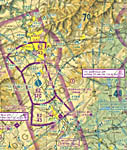VFR pilots should turn away when things turn IMC
(ATL03FA061)
 Scud running continues to be a temptation that many pilots succumb to. On March 14, 2003, the pilot of a Cessna 177 and his two passengers were killed when their aircraft hit mountainous terrain in Old Fort, North Carolina. Instrument meteorological conditions (IMC) prevailed at the time of the accident, and no flight plan had been filed for the flight from Asheville to Salisbury, North Carolina.
Scud running continues to be a temptation that many pilots succumb to. On March 14, 2003, the pilot of a Cessna 177 and his two passengers were killed when their aircraft hit mountainous terrain in Old Fort, North Carolina. Instrument meteorological conditions (IMC) prevailed at the time of the accident, and no flight plan had been filed for the flight from Asheville to Salisbury, North Carolina.
 The pilot contacted ground control at Asheville Regional Airport and stated that he intended to fly at 4,500 feet and his on-course heading would be due east. He went on to say, "...but I want to be sure that I don't get into the clouds going over the mountains." A controller responded by telling the pilot, "If you need to deviate around weather or something, just let me or departure know." The pilot was also advised the current weather included an overcast cloud layer at 2,500 feet and that it had been lowering all day. The pilot replied that he was aware of the ceiling.
The pilot contacted ground control at Asheville Regional Airport and stated that he intended to fly at 4,500 feet and his on-course heading would be due east. He went on to say, "...but I want to be sure that I don't get into the clouds going over the mountains." A controller responded by telling the pilot, "If you need to deviate around weather or something, just let me or departure know." The pilot was also advised the current weather included an overcast cloud layer at 2,500 feet and that it had been lowering all day. The pilot replied that he was aware of the ceiling.
After departing Ashville, the pilot contacted departure, and was instructed to turn left on course. The pilot told ATC, "If the clouds come down a bit, I may want to do some scud running. I may want to go up along the expressway to Asheville and over by Interstate 40." The flight was cleared to maneuver as necessary, and the pilot replied, "I'm gonna try and climb out and see what it's like up here."
Eight miles east of the Asheville airport, radar service was terminated and the pilot was given the frequency for Atlanta Center. There was no further contact with the pilot.
The aircraft wreckage was found in a heavily wooded area near the top of Kitsuma Peak (2,680 feet), 18 miles east of the Asheville airport, and 850 feet north of I-40.
The private pilot had 534 hours total time, 294 hours in the Cessna 177, and no instrument rating. His logbook also showed 2.7 hours of dual actual instrument time and 44.3 hours of simulated instrument time.
The NTSB determined that the cause of this accident was the pilot's decision to continue VFR flight into IMC and his failure to maintain terrain clearance.
Although the accident report does not say the pilot entered IMC, given the ceiling heights at the time, it is highly likely that he did. With the ceilings that low and the surrounding terrain, the best decision this pilot could have made was to stay on the ground. In 2003, nearly 70 percent of all fatal weather accidents were the result of VFR flight into IMC. The FAA created the instrument rating for a reason. Flying in the clouds requires additional training, and should not be attempted by pilots who do not have instrument ratings.
For additional information about VFR into IMC, see the AOPA Air SafetyInstitute's Spatial Disorientation Safety Advisor.
This accident report as well as others can be found in ASI's Online Database.